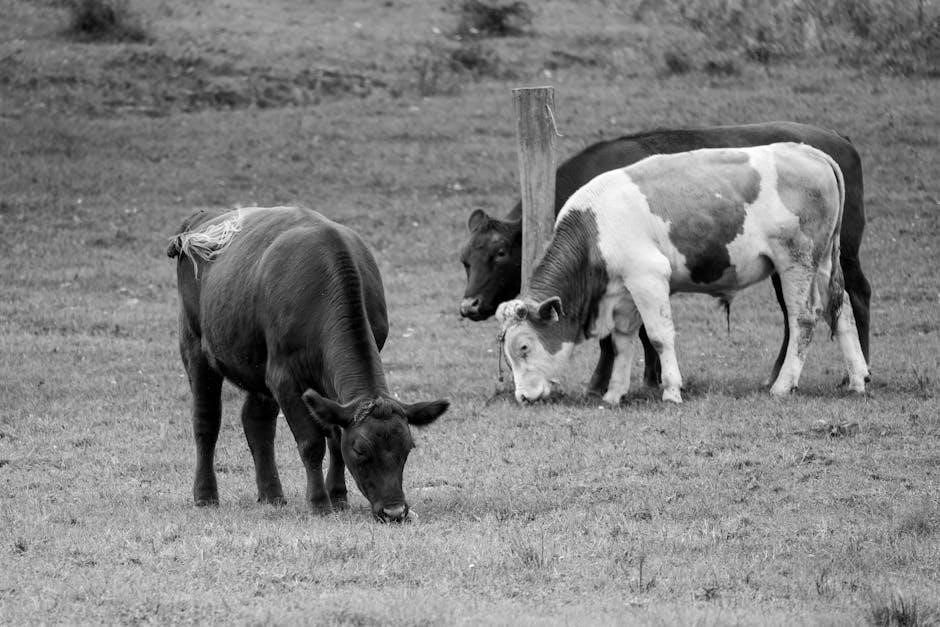LA-200 is a veterinary antibiotic commonly used in cattle treatment․ The standard dosage is 4․5 ml per 100 pounds of body weight, administered intramuscularly or subcutaneously․
Overview of LA-200
LA-200 is an oxytetracycline-based antibiotic solution designed for veterinary use․ It provides therapeutic levels in the blood for up to 3 days, treating bacterial infections like pneumonia and foot rot․ The standard dosage is 4․5 ml per 100 pounds of body weight, administered intramuscularly or subcutaneously․ It is approved for use in beef cattle, dairy cattle, calves, and swine․ For dairy cattle, a 96-hour milk disposal period is required․ Improvements in symptoms are typically seen within 24-48 hours, making it a reliable option for treating bacterial diseases in livestock․
Importance of Proper Dosage in Cattle Treatment
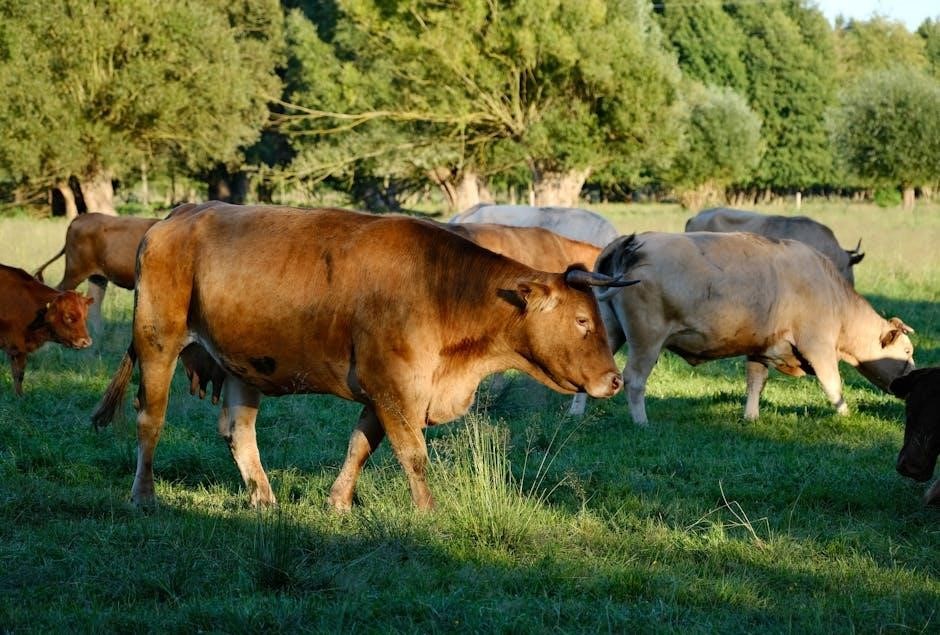
Proper dosage ensures effective treatment and prevents under or over-treatment․ Incorrect dosing can lead to reduced efficacy, antimicrobial resistance, or adverse reactions․ cattle require precise calculations based on body weight to achieve therapeutic levels․ Administering too little may fail to control infection, while excessive dosing can harm the animal․ Always follow the recommended guidelines and consult a veterinarian for accurate calculations․ Proper dosing also ensures safety, minimizing risks to the animal and maintaining residues within acceptable limits for meat and milk production․ Adhering to dosage instructions is critical for successful treatment outcomes and food safety compliance․
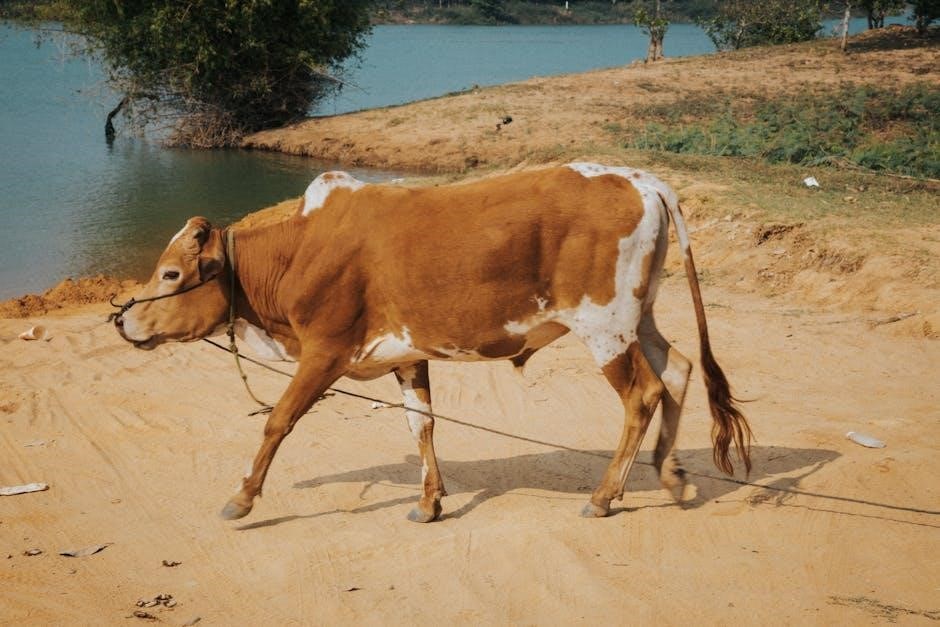
Understanding LA-200
LA-200 is a veterinary antibiotic containing oxytetracycline, effective against bacterial infections in cattle, including respiratory and gastrointestinal infections, promoting recovery and preventing disease spread․
What is LA-200?
LA-200 is a long-acting oxytetracycline antibiotic formulation designed for veterinary use, primarily in cattle․ It is effective against a wide range of gram-positive and gram-negative bacteria․ The “LA” in LA-200 stands for “long-acting,” referring to its sustained-release properties, which provide therapeutic levels of the drug in the animal’s system for an extended period․ This makes it ideal for treating infections such as pneumonia, foot rot, and other bacterial diseases in cattle․ LA-200 is administered via intramuscular injection and is known for its efficacy in promoting recovery and reducing the spread of disease in herds․ Proper dosing is essential for optimal results and safety․
Active Ingredient and Mechanism of Action
LA-200 contains oxytetracycline as its active ingredient, a broad-spectrum antibiotic belonging to the tetracycline class․ It works by binding to the 30S ribosomal subunit of bacteria, inhibiting protein synthesis and thereby preventing bacterial growth and replication․ This mechanism is effective against both gram-positive and gram-negative bacteria․ The long-acting formulation ensures sustained release of oxytetracycline, maintaining therapeutic levels in the bloodstream for extended periods․ This prolonged action enhances efficacy in treating infections and reduces the frequency of administration needed in cattle․
Indications for Use in Cattle
LA-200 is approved for treating bacterial infections in cattle, including respiratory diseases like pneumonia and infections caused by susceptible organisms․ It is a prescription-only medication․

Approved Uses for Cattle
LA-200 is FDA-approved for the treatment of bovine respiratory disease (BRD) and other infections caused by susceptible bacteria, such as Mannheimia haemolytica, Pasteurella multocida, and Histophilus somni․ It is also indicated for the control of infections like foot rot, metritis, and mastitis in cattle․ The drug is effective against gram-negative bacteria and is often prescribed for its long-lasting activity․ Always use LA-200 under veterinary guidance to ensure proper administration and dosage․ Dosage recommendations are provided in the product label or the ‘la-200 dosage for cattle per pound pdf’ for accurate treatment regimens․
Common Diseases Treated with LA-200
LA-200 is commonly used to treat bacterial infections in cattle, including bovine respiratory disease (BRD), bacterial pneumonia, and foot rot․ It is also effective against metritis, mastitis, and cellulitis․ The drug targets pathogens such as Mannheimia haemolytica, Pasteurella multocida, and Trueperella pyogenes․ Its broad-spectrum activity makes it a reliable option for various infections․ Dosage guidelines, outlined in the ‘la-200 dosage for cattle per pound pdf,’ ensure effective treatment while minimizing resistance risks․ Always consult a veterinarian for accurate diagnosis and treatment plans․
General Dosage Guidelines
LA-200 dosage for cattle typically ranges from 3-5 mg per pound of body weight, administered every 24 hours․ Treatment duration varies based on infection severity and veterinarian advice․
Standard Dosage Recommendations
LA-200 is typically administered at a standard dosage of 3-5 mg per pound of body weight in cattle․ This dosage is recommended for treating bacterial infections and should be given every 24 hours․ The medication is usually injected intramuscularly or subcutaneously, depending on the veterinarian’s advice․ It’s important to follow the prescribed dosage to ensure effectiveness and prevent resistance․ The treatment duration varies based on the severity of the infection but generally ranges from 3 to 5 days․ Always consult a veterinarian for precise dosage instructions tailored to the specific condition and animal․
Calculating Dosage Based on Body Weight
To determine the correct dosage of LA-200 for cattle, start by obtaining the animal’s accurate body weight in pounds․ The standard dosage is 3-5 mg per pound, depending on the severity of the infection․ Multiply the animal’s weight by the chosen dosage within this range․ For example, a 500-pound cow at 3 mg/lb requires 1,500 mg of LA-200․ Given the product’s concentration (typically 200 mg/mL), divide the total mg needed by the concentration to find the volume: 1,500 mg ÷ 200 mg/mL = 7․5 mL․ Adjust the dosage as prescribed by a veterinarian, ensuring not to exceed recommended limits or injection site volumes for safety and efficacy․

Administration Methods
LA-200 is typically administered via intramuscular or subcutaneous injection, ensuring proper technique to avoid tissue damage․ Always follow label instructions and veterinary guidance for safe, effective use․
Intramuscular Injection
Intramuscular (IM) injection is a common method for administering LA-200 in cattle․ It involves injecting the medication directly into a muscle, typically in the neck or hindquarter region․ This method ensures rapid absorption and effective distribution of the antibiotic․ Proper technique is crucial to avoid muscle damage or nerve irritation․ The injection site should be clean, and the needle should be inserted at a 90-degree angle․ The recommended volume per injection site is up to 10 mL to prevent discomfort and tissue damage․ Always use a 16-18 gauge needle for cattle to minimize pain and ensure proper delivery․ Consult a veterinarian for guidance on injection technique and site selection to maximize efficacy and safety․
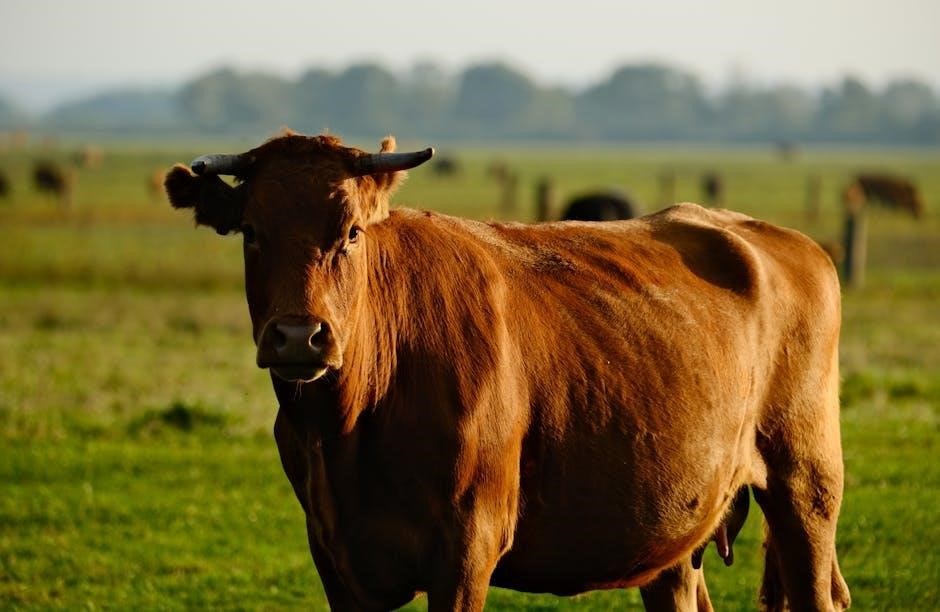
Subcutaneous Injection
Subcutaneous injection involves administering LA-200 under the skin, not into the muscle․ This method is often preferred for its slower absorption rate, which can be beneficial for certain infections․ The recommended dosage is typically 5-10 mg per pound of body weight, administered every 24 hours․ For subcutaneous injections, insert the needle at a 45-degree angle just beneath the skin, usually behind the ear or in the neck area․ Use a smaller gauge needle to minimize discomfort․ Ensure the injection site is clean to prevent infection and rotate sites to avoid irritation․ Always consult a veterinarian for proper technique and dosage advice․
Safety and Precautions
- Follow label instructions to minimize risks of residues in meat or milk․
- Avoid overdosing, as it may lead to adverse reactions․
- Wear protective gear when handling the product․
- Keep out of reach of children and pets․
- Dispose of unused product and packaging properly․
- Observe withdrawal periods before slaughter or milk use․
Withdrawal Period Before Slaughter
The withdrawal period for LA-200 in cattle is 28 days before slaughter to ensure no residues remain in meat․ This period allows the drug to metabolize and exit the system․ Failure to observe this can result in violative residues, posing risks to human health․ The withdrawal period applies to all cattle treated with LA-200, including beef and dairy animals․ Always adhere to the recommended timeframe to comply with food safety regulations․ Consult a veterinarian if unsure about the withdrawal period or its implications for your cattle operation․
Milk Disposal in Dairy Cattle
When administering LA-200 to dairy cattle, it’s crucial to adhere to milk disposal guidelines to avoid residue contamination․ The recommended milk discard period is 96 hours (4 days) after the last treatment․ During this time, milk from treated animals must not be used for human consumption or dairy products․ Proper disposal methods should be followed to prevent environmental contamination․ Always consult the product label or a veterinarian for specific instructions, as improper disposal can lead to regulatory issues and potential health risks; Adhering to these guidelines ensures both food safety and compliance with dairy industry standards․

Treatment Duration and Frequency
Treatment with LA-200 typically lasts 3-5 days, with doses administered every 24 hours․ Severe infections may require extended courses, up to 7 days․ Always follow veterinary guidance․
Recommended Treatment Duration
The recommended treatment duration with LA-200 in cattle is typically 3 to 5 days, depending on the severity of the infection․ For mild to moderate infections, a 3-day course is often sufficient․ However, in cases of severe or chronic infections, the treatment may extend up to 7 days․ It is crucial to adhere to the prescribed duration to ensure effectiveness and prevent the development of antibiotic resistance․ Always consult a veterinarian to determine the appropriate treatment length for specific conditions․ Never exceed the recommended duration without professional advice to avoid potential complications or side effects in the animal․
Frequency of Administration
LA-200 should be administered once daily, typically every 24 hours, to ensure consistent therapeutic levels in the animal․ The frequency is crucial for maintaining efficacy and preventing the development of resistance․ For most infections, a once-daily injection is sufficient․ However, in severe cases, your veterinarian may recommend a different schedule․ It is essential to follow the prescribed frequency strictly to avoid underdosing or overdosing․ Consistency in administration ensures the medication works effectively against the target pathogens․ Always administer the drug at evenly spaced intervals, as directed by your veterinarian, to maximize therapeutic outcomes in cattle․

Special Considerations
Special considerations include factors like animal health status, age, and injection technique to ensure safe and effective treatment outcomes in cattle․
Severe Infection Dosage Adjustment
In cases of severe infection, the LA-200 dosage for cattle may need to be adjusted to ensure effective treatment․ Typically, the dosage is increased by 25-50% compared to standard recommendations․ For cattle weighing 1,000 pounds, this could mean administering 6-9 mL instead of the usual 4-6 mL․ However, the maximum dose should not exceed 9 mL per 1,000 pounds to avoid toxicity․ A veterinarian should always be consulted to confirm the appropriate adjustment based on the severity of the infection and the animal’s overall health․ Overdosing can lead to adverse effects, so careful calculation is essential․
Maximum Injection Volume Per Site
The maximum injection volume per site for LA-200 in cattle is typically 10 mL․ Exceeding this volume can cause discomfort, swelling, or tissue damage at the injection site․ For doses requiring more than 10 mL, divide the total volume into multiple injection sites․ Ensure each site is spaced appropriately to avoid overlapping․ This practice helps maintain animal welfare and ensures the medication is well-tolerated․ Always follow the manufacturer’s guidelines or consult a veterinarian for specific recommendations, especially for larger or heavier animals requiring higher doses․ Proper administration techniques are crucial for efficacy and safety․
Guidelines for Different Cattle Categories
Guidelines for different cattle categories vary based on factors like weight, age, and health status․ Always consult a veterinarian to tailor dosages properly and ensure safety․ Adhere strictly to label instructions for optimal results․
Dosage for Beef Cattle
For beef cattle, the recommended dosage of LA-200 is typically 5 mg per pound of body weight, administered via intramuscular injection․ This dosage should be given once daily or as prescribed by a veterinarian․ Ensure accurate weight measurement to avoid underdosing or overdosing․ The treatment should continue for the recommended duration, usually 3-5 days, depending on the severity of infection․ Always follow label instructions and consult a veterinarian for specific guidance tailored to your cattle’s health and condition․
Dosage for Dairy Cattle
The recommended dosage of LA-200 for dairy cattle is 5 mg per pound of body weight, administered intramuscularly or subcutaneously․ Treatment should be given once daily for 3-5 days, depending on the infection severity․ Ensure accurate weight measurement to maintain efficacy and safety․ Milk from treated dairy cattle must be discarded during treatment and for 72 hours after the last dose to comply with milk withdrawal guidelines․ Always adhere to the veterinarian’s advice and label instructions to ensure proper treatment and food safety standards․
Dosage for Calves
For calves, the recommended dosage of LA-200 is 5 mg per pound of body weight, administered intramuscularly or subcutaneously․ Treatment should be given once daily for 3-5 days, depending on the severity of the infection․ Calves typically respond well to this dosage for respiratory issues like bovine respiratory disease (BRD)․ Ensure accurate weight measurement to avoid under- or over-dosing․ The maximum injection volume per site should not exceed 10 mL to prevent tissue irritation․ Always use a clean syringe for each calf to minimize the risk of disease transmission․ Consult a veterinarian for severe or chronic infections․
Dosage for Swine
Although primarily used in cattle, LA-200 can be administered to swine, particularly for bacterial infections․ The recommended dosage for swine is 5 mg per pound of body weight, given intramuscularly or subcutaneously․ Treatment typically lasts 3-5 days, depending on the severity of the infection․ Ensure accurate weight measurement to avoid improper dosing․ The maximum injection volume per site should not exceed 10 mL․ Administer once daily, preferably in the morning․ Always use sterile equipment to prevent secondary infections․ Consult a veterinarian for severe cases or prolonged treatment․

Monitoring and Side Effects
Monitor cattle for signs of improved health and potential side effects like injection-site reactions or gastrointestinal distress․ Ensure proper administration to minimize adverse reactions and enhance therapeutic outcomes effectively․
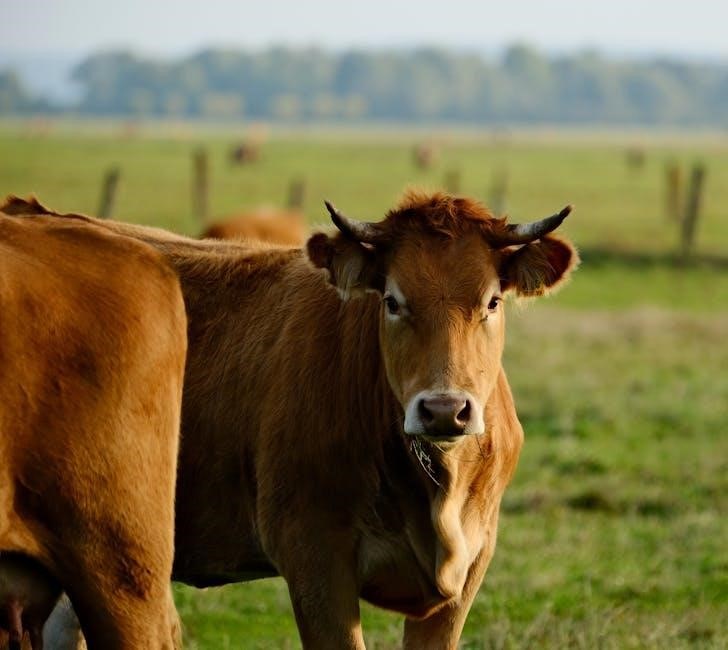
Monitoring for Efficacy and Side Effects
Regular monitoring of cattle treated with LA-200 is essential to assess treatment efficacy and detect potential side effects․ Farmers should observe clinical signs such as reduced fever, improved appetite, and enhanced mobility as indicators of effectiveness․ Additionally, watch for adverse reactions like injection-site swelling, lethargy, or digestive disturbances․ A veterinarian should be consulted if unexpected symptoms arise or if improvement is not observed within the expected timeframe; Daily monitoring ensures timely intervention and helps prevent complications, while maintaining accurate treatment records supports long-term animal health management and informed decision-making․ Always follow professional guidelines for monitoring protocols to optimize outcomes․
Common Side Effects in Cattle
Common side effects of LA-200 in cattle include injection-site reactions such as swelling or inflammation․ Gastrointestinal issues like diarrhea may also occur․ In rare cases, hypersensitivity reactions can happen, leading to more severe symptoms like anaphylaxis․ Most side effects are mild, but it’s important to monitor cattle closely․ If adverse reactions are severe or persistent, consult a veterinarian promptly․ Proper administration and dosage can help minimize these effects․ Always follow the recommended guidelines to ensure the health and safety of the animals․
LA-200 dosage for cattle is calculated based on body weight, typically 4․5-9 mg/kg of tetracycline per pound․ Administer via intramuscular or subcutaneous injection, ensuring proper technique to avoid tissue damage․ The withdrawal period before slaughter is 28 days, with milk disposal required for 96 hours post-treatment․ Treatment duration varies by condition, usually 3-5 days, but severe infections may require extended courses․ Always follow label instructions and consult a veterinarian for precise dosing, especially in severe cases or for specific cattle categories like beef, dairy, or calves․
Final Recommendations for Using LA-200 in Cattle
Always consult a veterinarian for accurate dosing based on the cattle’s weight and condition․ Adhere strictly to the label instructions and administer LA-200 via intramuscular or subcutaneous injection․ Ensure the dosage does not exceed 4․5-9 mg/kg per pound of body weight․ Avoid injecting more than 10 mL per site to prevent tissue damage․ Observe the 28-day withdrawal period before slaughter and discard milk for 96 hours post-treatment in dairy cattle․ Monitor for side effects and adjust treatment as needed․ Never exceed the recommended dosage to avoid toxicity․ Follow these guidelines for safe and effective use of LA-200 in cattle․
